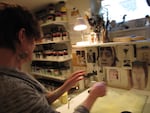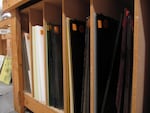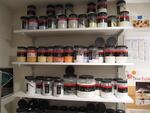
Catharine Newell in her home studio. She says her transition into fused glass has been nothing short of "transformative", and she credits Bullseye for making it possible.
April Baer / OPB
Glass artists are coming to terms with a world that has a bit less color in it.
Over the past few weeks you've heard us report on the emissions tests that revealed unhealthy levels of heavy metals near the Bullseye and Uroboros glass plants in Portland. Both companies suspended production of some colors. It's making ripples in the supply available to artists far beyond Oregon.
Catharine Newell stands in the studio built into the basement of her home in Portland's Laurelhurst neighborhood. You can hear the quiet clicking of her two kilns as Newell adjusts a fine layer of golden yellow sandy stuff sprinkled on a square of sheet glass.
"So, basically I've sifted the powder onto the panel, wearing a mask," Newell said, "and once I have some down, then I'll sometimes use a bit of cardboard or poster board and just kind of sweep it across."
Once this piece goes into the kiln, that yellow powder — frit, glassmakers call it — will bake down to form a matte, almost ceramic-looking finish.
Related: Complaints About Bullseye Glass Air Pollution Date Back to 1980s
"Colors are so emotive," Newell said. "When I choose a color, it's not because it's going to be pretty. I'll want something that maybe gives a punch of solidity or something to hold the piece down. Or I'll want to quiet it with another color. I don't use color wildly. So when I need it, I need it."
Newell's supplies came from Bullseye, the industry leader in art glass for fusing projects. She's taught at Bullseye's resource center in Southeast Portland (always using Bullseye products, she says), and she's shown her work five times at Bullseye galleries (there are four, nationwide) — including one that opened this week at Bullseye's New York space.
The supply of that particular yellow she's using is shrinking. On Feb. 4, Bullseye suspended production of 46 colors after environmental testing revealed unhealthy levels of cadmium and arsenic near their plants. Shades like Garnet Red, Spring Green and Burnt Orange are dwindling. Uroboros made similar reductions.
Global Glass Supplies Dwindle
The effect on the global supply of art glass was immediate. Brenda Page runs Blue Dog Glass in Victoria, Australia. Her studio holds classes and is also a distributor for glass supplies.
"The story broke around [Feb. 5] here," Page said. "And I think by the 10th we started to notice a lot of increased [sales] in the colors that were being suspended. We're pretty much sold out of our reds and yellow glasses at the moment."
Page does have one more shipment coming, but after that, there's no telling when she'll get more.
"And there's some artists who — that's the only color palette they'll use," she said.
Page's story isn't the only one. Bullseye's British distributor informed customers via its website it is auditing all orders, rejecting those that appear to be examples of blatant color hoarding.
How Bullseye Got Its Reach
To understand why Bullseye's emissions problem is affecting artists worldwide, it's helpful to know how the company captured so much market share.
Shawn Waggoner is the editor of Glass Art Magazine. She's interviewed two of the company's co-founders, and notes Bullseye's origins, 30 years ago, were very modest.
"Dan Schwoerer and one of his original partners, Boyce Lundstrom, drove up and down the West Coast selling glass out of the trunk of the VW Microbus," Waggoner says.

Sheet glass is Bullseye's cornerstone product.
April Baer / OPB
The team was making supplies for fused glass projects — mostly stuff that's assembled and baked in a kiln; glassblowers use different raw materials.
In addition to developing their line of sheet glass, Bullseye's founders worked with kiln makers to get fusion-friendly models to market. They taught classes all over the world.
Waggoner says Bullseye's reputation is grounded in making a broad range of colors that would fuse reliably. Many kinds of art glass before this were subject to minute variations in how they melted and combined. Even colors by the same maker sometimes could not be used together. The result, Waggoner says, was a lot of cracked final products.
Related: What You Need To Know About Heavy Metals Pollution In Portland
"Most of them required testing prior to using them, which for anyone renting a studio or making art for a living — time is money," she said. "And so to have a line of glasses that you could fuse together without experiencing breakage due to this incompatibility of the coefficient of expansion was pretty groundbreaking."
Suddenly, artists could do different things with glass, and work in a more vibrant colors. Fused glass took a bigger role in the contemporary art world. Bullseye funded residencies and sponsored exhibitions. And it added production in Portland, color after color.
How Did Bullseye Escape Regulation?
Bullseye was well within the terms of its air permits.
And it spent millions on handling hazards inside the factory — water systems, energy controls, and more. This week Bullseye suspended use of arsenic, indefinitely. It hired a consultant to recommend pollution-control devices.
But Bullseye CEO Dan Schwoerer told EarthFix in mid-February he was not aware of what other factories in the U.S. or internationally were doing about furnace emissions.
"I don't know specifically enough about other manufacturers," he said during an interview at Bullseye's headquarters. "We're working with our environmental consultant and another engineering firm to see how can we solve this problem, what's available."
Related: Why Portland Heavy Metals Pollution Went Undetected For So Long
While Schwoerer claims he was not aware of what was happening in Europe, Europe certainly was aware of the lack of regulation at Bullseye.
Peter Kuchinke is a glass artist based in Denmark. He's a glassblower and doesn't use Bullseye's products, but he's been to the factory in Portland.
"We could never understand in Europe how they could get around without any filters or controls," he told us in an interview this week.
For the past few decades, everyone from Czech glass bead factories to the historic studios of Venice has been retooling their operations, responding to gradually tightening environmental rules.
“We actually don't have many color-melting places left,” Kuchinke said.
Most of the European Union's rules have to do with carbon emissions, but a 2004 EU directive set up a target value for cadmium and arsenic in ambient air. According to a spokeswoman for the European Commission, EU glass makers are not considered a major contributor to heavy-metals emissions. But they still had to follow the rules. Factories added expensive filters to furnaces.
Kuchinke says he hopes the public does not assign all blame to Bullseye and Uroboros. The Northwest's glass factories, he says, have done artists a great service with their products.
But he's baffled at how no one — state regulators especially — asked what was coming out of Bullseye and Uroboros' chimneys.

Supplies from Catharine Newell's studio.
April Baer / OPB
Where Do Glassmakers Go From Here?
Beyond the regulation, Kuchinke has a theory about what's fundamentally different about the U.S. and European glass makers. In America, he notes, the studio glass movement was driven by artists striking out trying to make their own materials.
"While the studio glass business in America was people like Marvin Lipofsky or Dale Chihuly," Kuchinke said, "in Europe, we had mostly manufacturing businesses doing glass. Even if they were doing [art] glass, it was manufacturing businesses. And it wasn't small studios."
Kuchinke thinks the European art glass studios, coming out of the industrial base, had a stronger grasp of chemistry and environmental regulation and perhaps a more finely tuned sense of what emissions would be problematic.
Durk Valkema is a glass artist who has worked in a variety of studio settings throughout Europe. His father was one of the founders of Europe's studio glass movement. The younger Valkema now runs a company that makes compact furnaces and kilns.
"The art glass movement was restricted to whoever found their way into the existing factories," Valkema says. "It wasn't until the late '60s when glass was introduced at an academic level at art schools ... that studio glass became developed in Europe [and] small-scale production started."
Valkema says he thinks leaders at Bullseye and Uroboros will work to reach a solution
OPB reached out to Bullseye to ask about the apparent disparity in how emissions are handled on either side of the Atlantic. Spokesman Chris Edmonds wrote back:
“We are worldwide experts at glass making, not experts in worldwide regulations. Like most companies, we have an expectation that the regulations established by the Federal Government, the Oregon Department of Environmental Quality and the Oregon Legislature are protective. It would be impossible for Oregon companies, already subject to local, state and federal regulations, to be up-to-date, much less to follow whatever different rules might apply outside Oregon, in the European Union, or other nations.”
For the present, red, yellow, and orange fused glass supplies are in limbo.
Some manufacturing operations in China offer fused glass supplies. But those who have become accustomed to Bullseye's products don't sound ready to switch.
Instead, they're thinking about what the work will look like without half the available color spectrum. Portland artist Catharine Newell says the scarcity would mean re-thinking her practice.

Newell: "I know this material. This is what I'm sticking with."
Austin Cochrane / Courtesy of Catharine Newell
"Initially I would think that it's a pretty good exercise, you know, having to adapt to what is available," she said. "That's always a good exercise. But I think after a while, things would begin to feel very narrow. Color is an emotional choice. It triggers emotion. That's why you use it."
And for the moment, as one art dealer said, everyone's thankful for cobalt blue — one of the colors not affected by the production shutdown.
EarthFix's Cassandra Profita contributed to this report.
